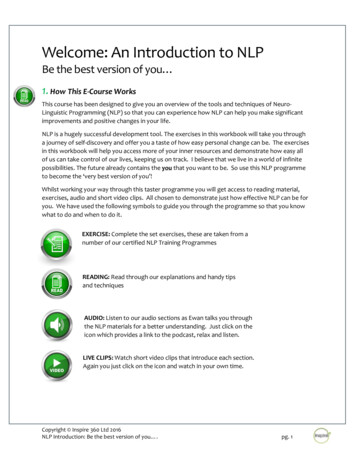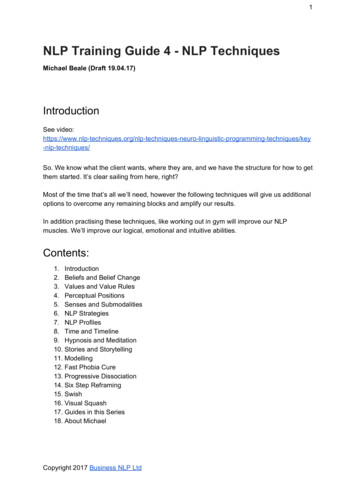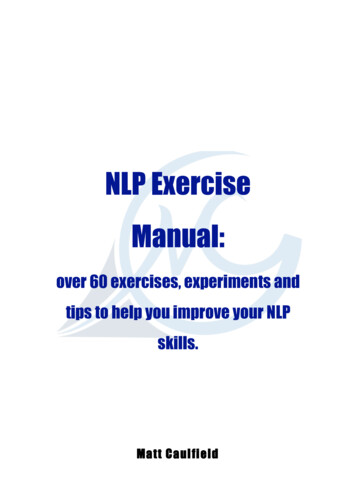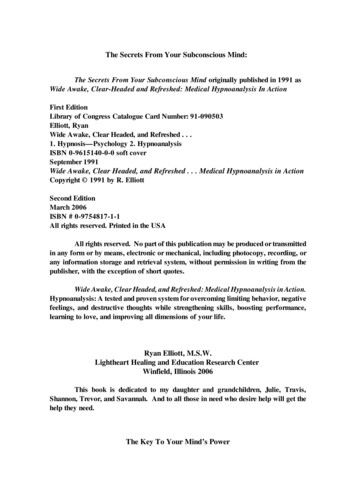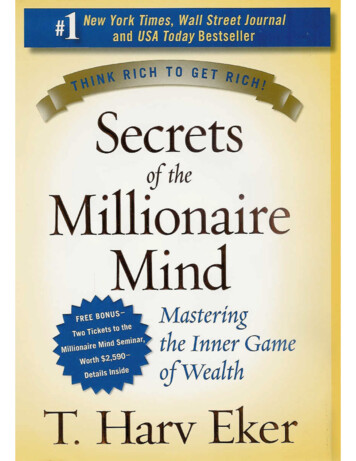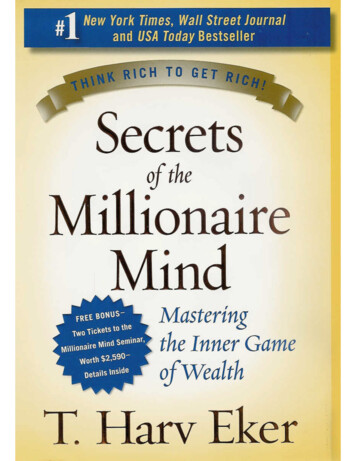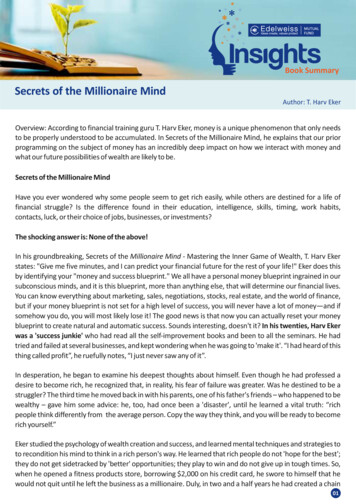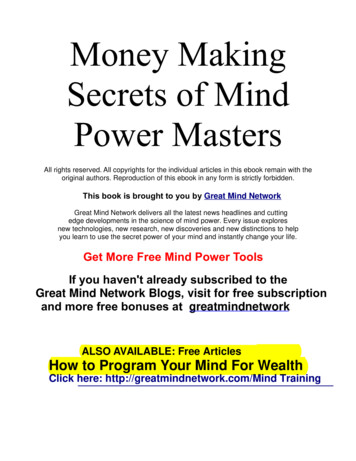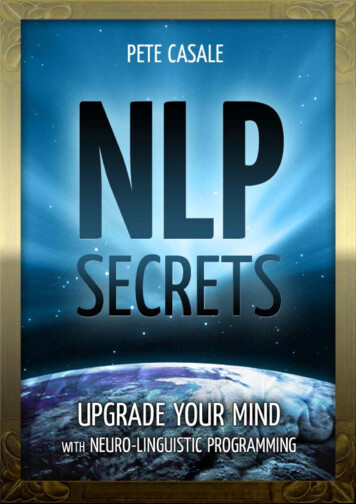
Transcription
NLP SECRETS: Upgrade Your Mind1
NLP Secrets: Upgrade Your Mind with Neuro-Linguistic Programming by Pete CasalePublished by Creative Media NZ LtdCover Design by Pete Casalewww.cre8ve.co.nzCopyright 2012 Creative Media NZ LtdWritten and Illustrated by Pete CasaleAll rights reserved. No part of this publication may be reproduced or utilized in any form or by anymeans, electronic or mechanical, including photocopying, recording, or by any information storage andretrieval system, without prior written permission of the publisher.DisclaimerThe advice in this book is provided as general information only. The publisher cannot guarantee that thisinformation is free of typographical or content errors. Furthermore, the content contains educational information only up to its original publication date. The publisher nor the author shall be held responsiblefor any negative effects on health or wellbeing as a result of using the techniques described.THE AUTHOR AND THE PUBLISHER WILL ASSUME NO LIABILITY NOR RESPONSIBILITY TO ANY PERSONOR ENTITY WITH RESPECT TO ANY LOSS OR DAMAGE RELATED DIRECTLY OR INDIRECTLY TO THE INFORMATION IN THIS BOOK. THE PUBLISHER WILL PROVIDE NO REMEDY FOR INDIRECT, CONSEQUENTIAL,PUNITIVE, OR INCIDENTAL DAMAGES ARISING FROM THIS BOOK, INCLUDING SUCH FROM NEGLIGENCE,STRICT LIABILITY, OR BREACH OF WARRANTY OR CONTRACT, EVEN AFTER NOTICE OF THE POSSIBILITYOF SUCH DAMAGES.2NLP SECRETS: Upgrade Your Mind
ContentsWhat Is NLP?. 5NLP TechniquesAnchoring. 8Pattern Interruption. 10Swish. 12Loop Break. 14Framing. 17The Meta Model. 22Presuppositions. 24Mirroring. 26Hypnosis. 28NLP ApplicationsSeduction. 33Confidence. 41Rapport. 46Lie Detecting. 50Phobias. 52Weight Loss. 56Quit Smoking. 60Final Thoughts. 63NLP SECRETS: Upgrade Your Mind3
ForewordThanks for buying my e-book! This is the culmination of many years of investigation into NLP. I beganwriting this book when I was 28 years old. Today I am 31 years old, about to turn 32.Over the years I have discovered myriad websites full of information about NLP. When I first beganstudying it, I believed it was a true science. Quickly, I realised that a lot of the NLP techniques outthere had no scientific basis whatsoever.I took it upon myself to find only the scientifically sound techniques, understand them, explain them,and apply them. The only techniques you find in this book are the ones that are backed up by the scientific method. Thus my motto:“If a technique has no scientific basis, or no noticeable effect better than that of a placebo or psychosomatics, then I am not interested.”This is the NLP secret. Enjoy!4NLP SECRETS: Upgrade Your Mind
What Is NLP?NLP, or neuro-linguistic programming, is a school of psychological techniques that effectively communicates with the listener’s subconscious or unconscious mind. In modern-day terms, brain-hax.The end result is that you can communicate / argue / negotiate / persuade people (or yourself) muchmore effectively. Astoundingly, significantly, suspiciously more effectively!Neuro: Pertaining the neurons, or nerves, the brain’s communication toolLinguistic: Pertaining to languageProgramming: To configure or set the way something worksWhat Can NLP Do?The tagline of this book is “Upgrade Your Mind” which is the best way I can describe the effects of NLP.You can upgrade your mindset, intelligence, memory, senses, appearance, and your communicationskills. You can gain the ability to improve, enhance or modify ANY aspect of yourself or someone else.NLP can be an extremely powerful tool, when used correctly. I have seen Derren Brown, a world-famous mentalist, use NLP techniques to talk a total stranger into giving him their wallet - in 20 secondsflat! NLP can be used on yourself as well as other people, with hundreds of opportunities to do so occurring every day.A Basic Example of NLPThe most basic example to illustrate this, is if I said to you:“Don’t think of a black cat!”What’s the first picture that came to your head? A black cat. The command “think of a black cat” laywithin that short sentence. Of course, before you have a chance to not think of a black cat, your unconscious brain has already put a picture of a black cat up and stuck a DON’T label on it saying “this isthe thing to not think about.”Very basic, yes? Everyone knows that. How could that possibly be used to help me communicate?Okay, how about we use that same lesson, and apply it to another example, slightly more useful.Imagine you’ve got a 5-year-old son, and he starts trotting towards a busy road. We’ve established thatif we yell to him “Don’t walk on the road!” - there is every chance he might take a split second longerthan usual to process the full command.NLP SECRETS: Upgrade Your Mind5
Instead, you’d say to him “Come here right now!” which might make a massive difference if a speedingcar is just seconds away.This is a very basic example of NLP (in fact it is barely classified as NLP, as it just scrapes the surface).Another example of this technique might be when people say to themselves “Okay, don’t forget to buymilk on the way home.” They are more likely to forget. Instead, they should say “Remember to buymilk when I’m passing the shop.” That way, they picture the shop as they say the word, and when theysee that picture in real life, ie, they are likely to remember to buy some milk.(If they wanted to be even more sure to remember the milk, they should say “When I pass the shop,I’ll have to be careful because milk will explode out the windows, covering me in cold milk.” This imagery invoke senses and emotions into the mnemonic - but that’s another subject!)On a level of 1 to 9, this technique is a 1 in terms of complexity and depth. There are hundreds of tinytricks we can use in neuro-linguistic programming, as you get higher in the scale you are getting closerto hypnosis.6NLP SECRETS: Upgrade Your Mind
Part OneNLP TechniquesThere are many different NLP techniques that can be used for many different purposes.Each NLP technique can be used by itself or in combination with other NLP techniquesto create fresh and effective methods of “getting inside the mind”. In this section we’lllook at eight of the best NLP techniques known to man.NLP SECRETS: Upgrade Your Mind7
AnchoringAnchoring is a useful NLP technique for inducing a certain frame ofmind or emotion, such as happiness or relaxation. It usually involves atouch, gesture or word as an “anchor”, like a bookmark for a desiredemotion, and recall it again later using that same anchor.How To Use AnchoringIn this example, I need you to remember a time when you were veryhappy, such as when you won a competition, had your first kiss, or hadsome really good news. It can be anything you like, as long as it was definitely a very happy moment.In your head, tell me the story of what happened leading up to that happy moment. Be vivid, and describe how it felt. Picture that moment in your head, and recall the feeling.I want you to hold your left index and middle fingers in your right hand, and gently give your fingerstwo quick squeezes. As you do the second squeeze, make the picture of the happy moment larger,bringing it closer to you, and imagine the happy feeling multiply in strength.Describe again how you are feeling. Describe what you were thinking at the time. As you do, squeezeyour fingers twice. On that second finger squeeze, the happy feeling doubles, again. The clearer youcan imagine the feeling, the better this technique will work. Repeat these steps until you have described then doubled the intensity of the feeling five times in a row.That’s the first part - laying the anchor. Later we can recall this anchor by using the exact same doublesqueeze to recall a sense of happiness.What is Happening in Our Brains When We Do This?You are psychologically associating the neural signal of “two squeezes on my left fingers” with “happy”.Therefore it stands to reason that the more times you lay the anchor (as above) and the more clarityyou have in the feeling, the better this technique will work. We can combine this with plenty of otherNLP techniques to make that feeling more clear and vivid, but for now we’ll make do. This is known asconditioning.The famous experiment by Russian scientist Ivan Pavlov describes him ringing a bell every time hisdogs were fed. The dogs psychologically associated the experience of eating with the sound of thebell. Later on, the dogs would start salivating at the mere ringing of the bell. This is similar to what weare doing when we are using the NLP technique of anchoring.8NLP SECRETS: Upgrade Your Mind
Examples of When To Use NLP AnchoringAnchoring is often used in seduction (covered later). The most obvious example is when one partyasks the other about a happy memory. When the seductee is “in the memory” - ie they are smiling orlaughing - the seductor uses either a distinct gesture or a light touch on the arm as an anchor. Whatever the anchor is, it mustn’t be too noticeable, otherwise it will appear unusual and the effect will fail.Later on, the seductor can use that anchor to make the seductee feel the same kind of happiness asbefore, when the seductor is getting closer. The seductee will recall a happy feeling, but will now associate that happy feeling with being close to the seductor. It’s a bit of a swindle, but it won’t work ifthere is no attraction in the first place.Personally, I use anchoring as a martial arts coach to improve my students’ feeling of reward whenthey do well. After I spar (fight) with one of my students, we shake hands, every time. However, if mystudent has been pressed and puts up a good fight, I will add a light punch on the shoulder duringthe handshake. Sparring can be intense, and is often accompanied by adrenaline, and the associatedendorphins (pleasurable feeling).By using the punch on the arm anchor repeatedly, my students begin to associate it with the pleasureof post-adrenaline endorphins. Using the same NLP idea behind Pavlov’s dogs, I can eventually inducethose same endorphins, just by doing that light punch. This is very useful when students are nervous /stressed before a tournament fight or grading.Try it now, or before you go to bed tonight. Squeeze your fingers twice as you did before. It is more difficult to do on yourself, so perhaps try this technique with a willing partner. As with all NLP techniques,practice makes perfect!NLP SECRETS: Upgrade Your Mind9
Pattern InterruptionPattern interruption is an effective NLP technique for storing key wordsinto a listener’s subconscious mind. This can be combined with otherNLP techniques such as anchoring for some excellent party tricks, or togive someone a message that for reasons unknown to them appearsvery heart-felt or significant.Pattern interruption works by luring the listener’s inner monologueor even their pure subconscious train of thought into a pattern orsequence. When that pattern is established, you then jolt them out ofthat pattern at a critical moment before the pattern completes. Thisleaves the listener’s subconscious mind waiting for the next part of the pattern to occur, while theirconscious mind is distracted.So What Exactly is Pattern Interruption?Let’s use an analogy. Say you had an old man who has a pet dog to do all his actions for him. The oldman represents our conscious mind and the dog represents the unconscious mind. The man (conscious)makes the decisions, and the dog (subconscious) performs various necessary actions for that man.Step one. We ask the old man for a sandwich. The man then asks his dog to go get some bread, slicesome cheese, put it on a plate, and bring to me.Follow me so far?Step two. We ask the old man for another sandwich. The man then gives his dog the same sequenceof commands. The dog gets the bread, slices the cheese, puts it on the plate, and SLAP! We slap theman in the face and ask him to do a dance. Before the dog has been given the final command for thesandwich (bring to me) the pattern has been interrupted and new commands given.The old man (conscious mind) being far less clever than to dog (unconscious mind) has forgotten allabout that final stage of the sandwich pending. But the dog has not forgotten. The dog cannot speakto the man, but is thinking “what about the command ‘bring it to me’ which I still haven’t done yet?”The dog will keep thinking of this last command for quite awhile.Step three. If I’m mean, I can ask the old man to give me his wallet. The man might ask his dog “heydog, I’m thinking about giving you a com
NLP SECRETS: Upgrade Your Mind Anchoring Anchoring is a useful NLP technique for inducing a certain frame of mind or emotion, such as happiness or relaxation. It usually involves a touch, gesture or word as an “anchor”, like a bookmark for a desired emotion, and recall it again later using that same anchor. How To Use Anchoring
